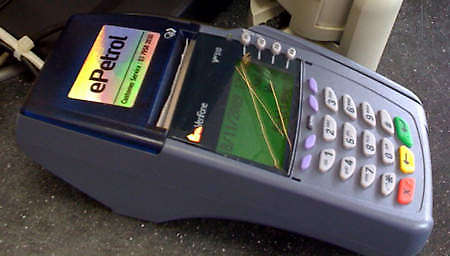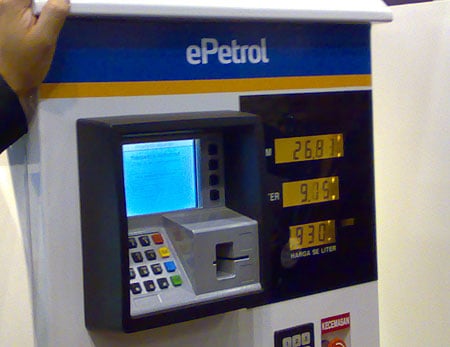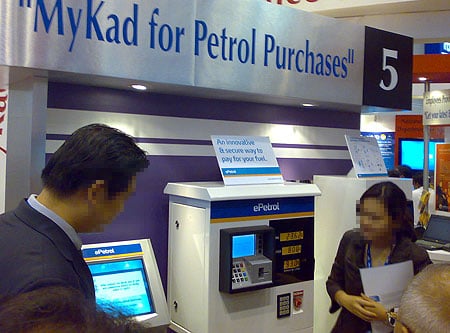
I spotted the above device while paying for a bottle of mineral water at the BHPetrol station in Kayu Ara last week. The logo was immediately recognisable to me. I had saw it before at the WCIT 2008 where this particular company ePetrol had displayed a petrol subsidy management system at the IT conference.

At the WCIT 2008 conference, ePetrol was demonstrating a way that fuel subsidies could be controlled and given to Malaysians only. In their implementation at that time, the petrol kiosk displays and charges the unsubsidised market price for petrol by default.
When an ePetrol-enabled MyKad is inserted, the subsidised price will be available. The petrol receipt (which I saw back at the event but for some reasons did not take pix of) shows both the unsubsidised price and the subsidy given.

When I asked the person at the petrol station’s cashier what this ePetrol thingy was for, she said it had been there for over a year and was used to accept MyKad petrol purchases.
Apparently ePetrol and EON Bank launched a pilot project in September last year for 250 EON Bank customers to use their MyKad to pay for fuel purchases at certain selected BHPetrol and Caltex stations. During the pilot trial, ePetrol gave the trial users a discount of 15 sen per litre up to 150 litres a month. You can probably consider the 15 sen discount effectively a test of a potential subsidy system.
ePetrol revealed at the WCIT 2008 that its system had a subsidy management system module. The module is able to identify MyKad holders entitled to fuel subsidies, manage the amount of subsidies allocated to each consumer, controlling the frequency of the subsidy provided (weekly limits, monthly limits, etc), and managing how the subsidy is provided (lump sum each month or a percentage of each purchase).
This would mean that a technical system for a MyKad-based subsidy system to be implemented has already been undergoing testing for over a year. Now one big question mark is for the government to finalise the nitty gritty details on how to determine who gets subsidies and how much subsidies they should get. The ePetrol system will be reprogrammed, implemented in all stations (this could possibly be a costly thing), and wala! You have a subsidy system set in place.
As an example, a single Shell card terminal at the pump is able to accept credit cards, Bonuslink cards, and also their Shell fleet cards. I’m not too sure on the technicalities but perhaps the existing chip-based readers at the kiosks could be reprogrammed to read the MyKad in addition to the credit cards, prepaid fleet cards and loyalty cards that they currently accept.
Right now, a MyKad is activated in the ePetrol system by registering the MyKad at an ePetrol registration kiosk. This will open an ePetrol account for the MyKad holder. There will be an option for the MyKad holder to link his ePetrol account with his bank account (tested with EON Bank in the trial period). This means ePetrol bank-linked MyKads can be used as an electronic cash payment at the petrol pumps if you do not have a credit card. No more walking from your car and queuing at the cashier before getting back to your car to pump your fuel in.
I think the system is by theory technically sound, with the weak points potentially being the quality of our MyKad (always cannot be read), and the communication link between the petrol station and the ePetrol system. The subsidy management module seems flexible enough and all that needs to be done is for the government to develop a fair system that has as little loop holes as possible.
Last we heard, the system was scheduled to be implemented in May 2010.
Looking to sell your car? Sell it with Carro.











AI-generated Summary ✨
Comments express concerns about the potential for misuse and loopholes in the ePetrol subsidy system, such as cheating vehicle modifications, using family members' MyKads, and illicitly sharing cards, which could undermine its effectiveness. There is skepticism about implementation challenges, including machine reliability, privacy issues, and administrative costs. Some believe the system might unjustly penalize middle- and low-income earners or create administrative burdens, while others highlight the importance of tightening enforcement against subsidized petrol abuse, especially at borders. Several commenters argue for better transparent policies like income-based subsidies or leveraging existing systems like income tax, raising worries about corruption, cost, and practicality. Overall, sentiments are mixed, with many highlighting risks of inefficiency, potential inequity, and the need for careful, transparent implementation.